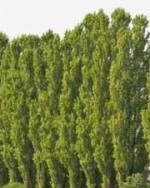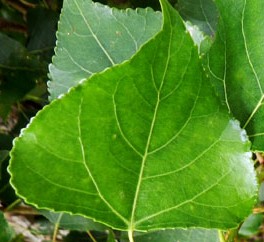 Lombardy poplar is a deciduous, short-lived, male clone of Populus nigra. It is a native of Italy where it grows in moist areas and is a member of the willow family, Saliaceae, that also includes cottonwood and aspen. The tree is narrow with short upward reaching branches and a symmetrical crown. The bark of young trees is greenish gray but matures to black, furrowed bark on old trees. The leaves are triangular to diamond shaped, 2 to 4 inches long by 1.5 to 3 inches wide, and are bright green until fall when they turn bright golden yellow. The inconspicuous red male flowers appear in three inch long catkins in the spring and there are no fruits or seeds. The rapid growth, adaptability to various soil conditions, and columnar form of Lombardy popular recommend it for screens and wind breaks but its short life span, litter, invasive root system, sensitivity to pests and diseases, and tendency to topple and/or break in high winds limit its use. If Lombardy popular is used in the landscape locate it away from drains, sewers, sidewalks and lawns to avoid problems with invasive root growth.
Lombardy poplar is a deciduous, short-lived, male clone of Populus nigra. It is a native of Italy where it grows in moist areas and is a member of the willow family, Saliaceae, that also includes cottonwood and aspen. The tree is narrow with short upward reaching branches and a symmetrical crown. The bark of young trees is greenish gray but matures to black, furrowed bark on old trees. The leaves are triangular to diamond shaped, 2 to 4 inches long by 1.5 to 3 inches wide, and are bright green until fall when they turn bright golden yellow. The inconspicuous red male flowers appear in three inch long catkins in the spring and there are no fruits or seeds. The rapid growth, adaptability to various soil conditions, and columnar form of Lombardy popular recommend it for screens and wind breaks but its short life span, litter, invasive root system, sensitivity to pests and diseases, and tendency to topple and/or break in high winds limit its use. If Lombardy popular is used in the landscape locate it away from drains, sewers, sidewalks and lawns to avoid problems with invasive root growth.
 Type: Deciduous tree
Type: Deciduous tree
Outstanding Features: Columnar form, fall coloration, rapid growth
Form: Columnar with symmetrical crown
Growth Rate: Rapid
Bloom: Inconspicuous red male flowers in spring
Size: 40-90’ H x 10-25’ W (rarely lives long enough to achieve full potential)
Light: Sun
Soil: Deep, wet to dry
Hardiness: Zones 3-9
Care: Occassional heading up; in fall
Pests and Diseases: Aphids, borers, caterpillars, scale, thrips, canker, dieback, leaf spot, rust, powdery mildew
Propagation: Cuttings only since no seed is produced